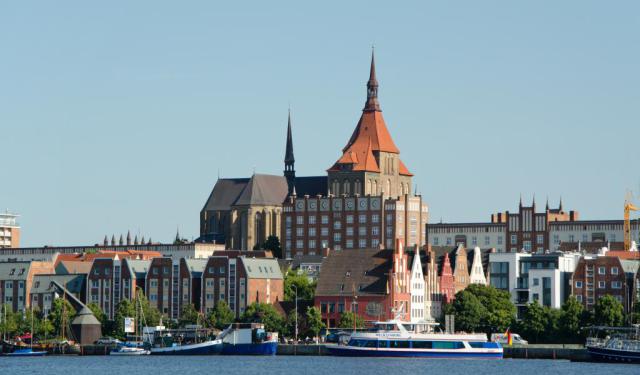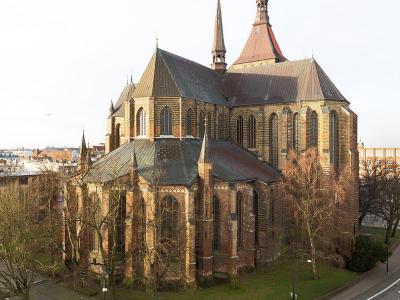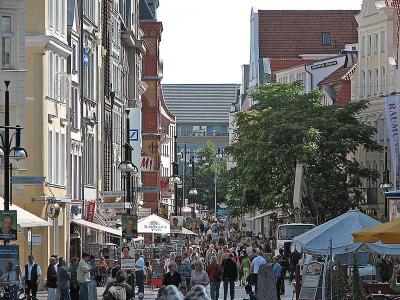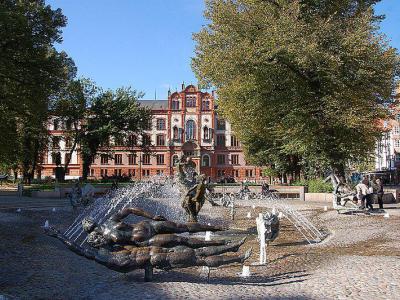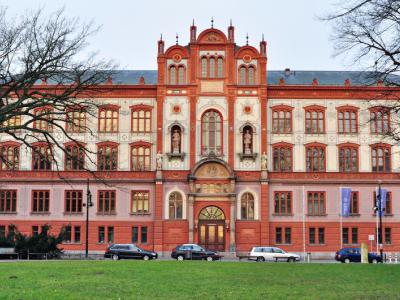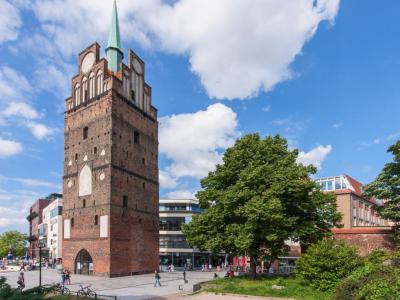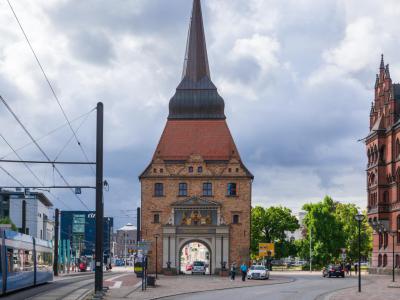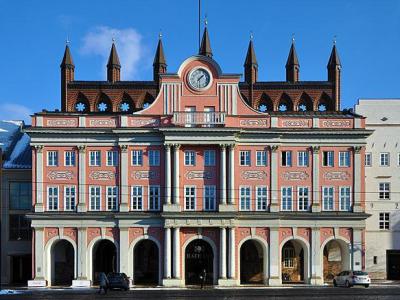Rostock Introduction Walking Tour (Self Guided), Rostock
According to Germany's prestigious Historic Highlights list, the lovely town of Rostock on the Baltic Coast is one of the country's 16 lesser-known destinations that you may wish to explore. They say a day trip here is a must for anyone visiting Berlin or Hamburg.
Rostock was originally founded by Polabian Slavs in the 11th century as "Roztoc," which means "fork of a river", a nod to its location on the Warnow River. In 1161, Rostock suffered a devastating fire under the rule of Danish King Valdemar I, leading to its resettlement by German traders.
The city's pivotal moment came in 1251 when it joined the Hanseatic League, emerging as a potent seaport in the 14th century. Rostock expanded by incorporating the fishing village of Warnemünde in 1323 and establishing the University of Rostock in 1419, marking a significant intellectual milestone.
However, the late 15th century witnessed the city's decline, as the Dukes of Mecklenburg gained control, suppressing Rostock's autonomy. John Albert I dismantled its walls in 1565, eventually leading to the Rostock Inheritance Agreement in 1573.
Rostock's strategic location invited occupation by rival powers, including Danes, Swedes, and French, from the 1600s to 1800s. In the 19th century, the city reemerged as an economic hub due to the wheat trade and later industrialization, notably shipyards.
The 20th century brought both progress and turmoil. Rostock excelled in aircraft manufacturing, witnessed Nazi Party influence in the 1930s, endured destruction during WWII, and became East Germany's largest seaport post-war. Modern Rostock and Warnemünde are now thriving Baltic Sea tourist destinations.
One of the most iconic sites in Rostock is the New Market (Neuer Markt), a picturesque historic square that dates back to the 13th century and is surrounded by colorful gabled houses.
Saint Mary's Church (Sankt Marien Kirche) is another jewel in Rostock's crown. This towering Gothic masterpiece dominates the city's skyline and boasts an intricate astronomical clock.
Kropeliner Street is a charming thoroughfare that leads you through the heart of the city.
For a touch of whimsy, be sure to visit the Fountain of Joy of Life (Brunnen der Lebensfreude), a cheerful sculpture that exudes positivity and lightens the spirit.
The multifaceted history of Rostock underscores its resilience and evolution. The city's storied streets are simply designed for wandering. If you're intrigued, take our self-guided tour and make the most of your day in this beautiful coastal city!
Rostock was originally founded by Polabian Slavs in the 11th century as "Roztoc," which means "fork of a river", a nod to its location on the Warnow River. In 1161, Rostock suffered a devastating fire under the rule of Danish King Valdemar I, leading to its resettlement by German traders.
The city's pivotal moment came in 1251 when it joined the Hanseatic League, emerging as a potent seaport in the 14th century. Rostock expanded by incorporating the fishing village of Warnemünde in 1323 and establishing the University of Rostock in 1419, marking a significant intellectual milestone.
However, the late 15th century witnessed the city's decline, as the Dukes of Mecklenburg gained control, suppressing Rostock's autonomy. John Albert I dismantled its walls in 1565, eventually leading to the Rostock Inheritance Agreement in 1573.
Rostock's strategic location invited occupation by rival powers, including Danes, Swedes, and French, from the 1600s to 1800s. In the 19th century, the city reemerged as an economic hub due to the wheat trade and later industrialization, notably shipyards.
The 20th century brought both progress and turmoil. Rostock excelled in aircraft manufacturing, witnessed Nazi Party influence in the 1930s, endured destruction during WWII, and became East Germany's largest seaport post-war. Modern Rostock and Warnemünde are now thriving Baltic Sea tourist destinations.
One of the most iconic sites in Rostock is the New Market (Neuer Markt), a picturesque historic square that dates back to the 13th century and is surrounded by colorful gabled houses.
Saint Mary's Church (Sankt Marien Kirche) is another jewel in Rostock's crown. This towering Gothic masterpiece dominates the city's skyline and boasts an intricate astronomical clock.
Kropeliner Street is a charming thoroughfare that leads you through the heart of the city.
For a touch of whimsy, be sure to visit the Fountain of Joy of Life (Brunnen der Lebensfreude), a cheerful sculpture that exudes positivity and lightens the spirit.
The multifaceted history of Rostock underscores its resilience and evolution. The city's storied streets are simply designed for wandering. If you're intrigued, take our self-guided tour and make the most of your day in this beautiful coastal city!
How it works: Download the app "GPSmyCity: Walks in 1K+ Cities" from Apple App Store or Google Play Store to your mobile phone or tablet. The app turns your mobile device into a personal tour guide and its built-in GPS navigation functions guide you from one tour stop to next. The app works offline, so no data plan is needed when traveling abroad.
Rostock Introduction Walking Tour Map
Guide Name: Rostock Introduction Walking Tour
Guide Location: Germany » Rostock (See other walking tours in Rostock)
Guide Type: Self-guided Walking Tour (Sightseeing)
# of Attractions: 11
Tour Duration: 2 Hour(s)
Travel Distance: 2.9 Km or 1.8 Miles
Author: DanaOffice
Sight(s) Featured in This Guide:
Guide Location: Germany » Rostock (See other walking tours in Rostock)
Guide Type: Self-guided Walking Tour (Sightseeing)
# of Attractions: 11
Tour Duration: 2 Hour(s)
Travel Distance: 2.9 Km or 1.8 Miles
Author: DanaOffice
Sight(s) Featured in This Guide:
- Neuer Markt (New Market)
- Sankt Marien Kirche (Saint Mary's Church)
- Kropeliner Strabe (Kropeliner Street)
- Brunnen der Lebensfreude (Fountain of Joy of Life)
- University of Rostock
- Das Kropeliner Tor (Kropelin Gate)
- Kloster zum Heiligen Kreuz (Convent of the Holy Cross)
- Standehaus (Estates House)
- Steintor (Stone Gate)
- Rostock City Wall and Cow Gate
- Rathaus (Town Hall)
1) Neuer Markt (New Market) (must see)
New Market stands out as one of the most picturesque and historically significant squares in the city. This charming square is dominated by the Town Hall, originally constructed in the 13th century in the distinctive Brick Gothic style.
One of the square's most striking features is the preservation of six original gable houses dating back to the 15th and 16th centuries, meticulously restored to their former glory. These houses provide a glimpse into the architectural splendor of the past. Unfortunately, during an Allied air raid in 1942, many other historical houses in Hanseatic style that once lined the square were destroyed. These were subsequently rebuilt in a simplified fashion.
Throughout history, the New Market served as the economic heart of the city during the Middle Ages. The Town Hall, adorned with its characteristic seven towers, marks the eastern boundary of the square. On the northwestern corner, the imposing Saint Mary's Church rises majestically. To the west, the pedestrian zone of the city center commences with Kropeliner Street.
In earlier times, the New Market fulfilled various roles, serving as a parade ground and even a parking area. Today, it has transformed into a vibrant hub with colorful stalls and bustling markets. Visitors can enjoy the lively atmosphere and a wide array of goods available here daily, with the exception of Wednesdays and Sundays.
One of the square's most striking features is the preservation of six original gable houses dating back to the 15th and 16th centuries, meticulously restored to their former glory. These houses provide a glimpse into the architectural splendor of the past. Unfortunately, during an Allied air raid in 1942, many other historical houses in Hanseatic style that once lined the square were destroyed. These were subsequently rebuilt in a simplified fashion.
Throughout history, the New Market served as the economic heart of the city during the Middle Ages. The Town Hall, adorned with its characteristic seven towers, marks the eastern boundary of the square. On the northwestern corner, the imposing Saint Mary's Church rises majestically. To the west, the pedestrian zone of the city center commences with Kropeliner Street.
In earlier times, the New Market fulfilled various roles, serving as a parade ground and even a parking area. Today, it has transformed into a vibrant hub with colorful stalls and bustling markets. Visitors can enjoy the lively atmosphere and a wide array of goods available here daily, with the exception of Wednesdays and Sundays.
2) Sankt Marien Kirche (Saint Mary's Church) (must see)
Saint Mary's Church is not only the largest church in Rostock but also one of the most significant brickstone Gothic buildings in the entire Baltic region. For over 770 years, it has served as a sacred space for prayer, worship, civic and academic gatherings, and a hub for artistic expression.
The mighty presence of Saint Mary's Church has graced Rostock's market square and defined the city's silhouette for centuries. The church's historical roots date back to 1232, with the current building believed to be the successor to the original structure. The church's current structure is the result of several construction phases.
Saint Mary's is a triple-nave cross-shaped basilica, exemplifying the Brick Gothic architectural style typical of Hanseatic port cities in northern Germany. Its grand tower, crowned with a baroque lantern, was not completed until the late 18th century.
One of the most remarkable features of Saint Mary's Church is its astronomical clock, crafted in 1472 by Hans Düringer, a skilled clockmaker from Nuremberg. This intricate timepiece still functions with its original clockwork. The clock's late Gothic elements include a lower ring adorned with zodiac signs, reliefs depicting four wise men from antiquity, and an upper clock face displaying moon phases and symbols of the evangelists.
Another awe-inspiring facet of the church is its monumental south portal window located in the transept, towering at a height of 26 meters. This magnificent stained glass window depicts "The Day of Judgment" and ranks among the largest single stained glass windows in all of Europe. Saint Mary's Church not only serves as a place of worship but also as a living museum of history and art, inviting visitors to marvel at its architectural splendor and rich heritage.
The mighty presence of Saint Mary's Church has graced Rostock's market square and defined the city's silhouette for centuries. The church's historical roots date back to 1232, with the current building believed to be the successor to the original structure. The church's current structure is the result of several construction phases.
Saint Mary's is a triple-nave cross-shaped basilica, exemplifying the Brick Gothic architectural style typical of Hanseatic port cities in northern Germany. Its grand tower, crowned with a baroque lantern, was not completed until the late 18th century.
One of the most remarkable features of Saint Mary's Church is its astronomical clock, crafted in 1472 by Hans Düringer, a skilled clockmaker from Nuremberg. This intricate timepiece still functions with its original clockwork. The clock's late Gothic elements include a lower ring adorned with zodiac signs, reliefs depicting four wise men from antiquity, and an upper clock face displaying moon phases and symbols of the evangelists.
Another awe-inspiring facet of the church is its monumental south portal window located in the transept, towering at a height of 26 meters. This magnificent stained glass window depicts "The Day of Judgment" and ranks among the largest single stained glass windows in all of Europe. Saint Mary's Church not only serves as a place of worship but also as a living museum of history and art, inviting visitors to marvel at its architectural splendor and rich heritage.
3) Kropeliner Strabe (Kropeliner Street)
Kropeliner Street is the bustling heart of the city's historic center and serves as the primary shopping thoroughfare. This charming street is renowned for its collection of traditional gabled houses, many of which have been painstakingly restored, showcasing their intricately designed and colorful facades.
Kropeliner Street boasts a remarkable architectural heritage, featuring approximately 40 buildings representing various stylistic periods. Among these architectural treasures are examples of brick Gothic and Renaissance from the Hanseatic era, classicism, baroque, historicism, and postmodernism.
The lively University Square, situated at the heart of Kropeliner Street , serves as a focal point for locals and visitors alike. At the western end of the street stands the impressive Kropeliner Tower, an iconic city gate that harks back to the city's medieval past. Additionally, the building housing the city library is a noteworthy architectural gem worth exploring.
Kropeliner Street has a storied history. In 1961, the tramway was relocated to Lange Street, and in 1968, the street was transformed into one of the GDR's first pedestrian zones. This move breathed new life into Kropeliner Strabe, making it a vibrant and welcoming destination for shoppers and pedestrians.
Today, the street enjoys considerable foot traffic, attracting approximately 5,000 people per hour. Its enduring popularity can be attributed, in part, to its diverse array of shopping opportunities. Over 250 shops line the street, offering a wide range of goods and products across a total sales area exceeding 6.2 hectares.
Kropeliner Street boasts a remarkable architectural heritage, featuring approximately 40 buildings representing various stylistic periods. Among these architectural treasures are examples of brick Gothic and Renaissance from the Hanseatic era, classicism, baroque, historicism, and postmodernism.
The lively University Square, situated at the heart of Kropeliner Street , serves as a focal point for locals and visitors alike. At the western end of the street stands the impressive Kropeliner Tower, an iconic city gate that harks back to the city's medieval past. Additionally, the building housing the city library is a noteworthy architectural gem worth exploring.
Kropeliner Street has a storied history. In 1961, the tramway was relocated to Lange Street, and in 1968, the street was transformed into one of the GDR's first pedestrian zones. This move breathed new life into Kropeliner Strabe, making it a vibrant and welcoming destination for shoppers and pedestrians.
Today, the street enjoys considerable foot traffic, attracting approximately 5,000 people per hour. Its enduring popularity can be attributed, in part, to its diverse array of shopping opportunities. Over 250 shops line the street, offering a wide range of goods and products across a total sales area exceeding 6.2 hectares.
4) Brunnen der Lebensfreude (Fountain of Joy of Life)
The "Fountain of Joy of Life" graces the University Square. This splendid fountain was brought to life through the collaborative efforts of Rostock's talented artists, Reinhard Dietrich and Jo Jastram, and was officially inaugurated on June 27, 1980.
The "Fountain of Joy of Life" has become an iconic landmark and serves as both an artistic expression and a symbol of the profound connections that bind humanity, animals, and water. Its design features groups of sculpted figures, a total of 26 bubbling water jets, and 18 enchanting fountains.
The fountain's name, "Joy of Life," suggests the exuberance and vitality that it brings to the University Square, creating a lively and inviting atmosphere for all who visit.
The "Fountain of Joy of Life" has become an iconic landmark and serves as both an artistic expression and a symbol of the profound connections that bind humanity, animals, and water. Its design features groups of sculpted figures, a total of 26 bubbling water jets, and 18 enchanting fountains.
The fountain's name, "Joy of Life," suggests the exuberance and vitality that it brings to the University Square, creating a lively and inviting atmosphere for all who visit.
5) University of Rostock
Founded in 1419 under the name Alma Mater Rostochiensis, the University of Rostock stands as a venerable institution with deep-rooted traditions. It holds the distinction of being the oldest university in the Baltic Sea region. With approximately 15,000 students, the University of Rostock currently holds the distinction of being the largest university in Mecklenburg-Vorpommern, too. The University main building was erected in the years 1867 – 1870 and is an example of Renaissance Revival architecture in Mecklenburg.
The university's heyday began in 1563 when the rulers and the City of Rostock negotiated equal status in patronage, ushering in an era of academic growth and prosperity. However, in the middle of the 17th century, the university's prominence waned due to the impact of wars, a devastating city fire, and the decline of the Hanseatic League.
It wasn't until the 19th century that the University of Rostock began its journey of revival. With the fall of the Berlin Wall, a commitment to modernization and progress was embraced, making the university an attractive destination for students from all corners of the globe.
Today, the university's main building primarily consists of two parts: the southern wing, known as the New Museum, was constructed in 1844 as a "Museum for the University of Rostock," designed by the accomplished architect Georg Adolph Demmler. Additionally, from 1867 to 1870, the central building and the right wing were constructed on the site of the old university, the White College, under the architectural vision of Helmuth Bogislav Hermann Willebrand.
The university's heyday began in 1563 when the rulers and the City of Rostock negotiated equal status in patronage, ushering in an era of academic growth and prosperity. However, in the middle of the 17th century, the university's prominence waned due to the impact of wars, a devastating city fire, and the decline of the Hanseatic League.
It wasn't until the 19th century that the University of Rostock began its journey of revival. With the fall of the Berlin Wall, a commitment to modernization and progress was embraced, making the university an attractive destination for students from all corners of the globe.
Today, the university's main building primarily consists of two parts: the southern wing, known as the New Museum, was constructed in 1844 as a "Museum for the University of Rostock," designed by the accomplished architect Georg Adolph Demmler. Additionally, from 1867 to 1870, the central building and the right wing were constructed on the site of the old university, the White College, under the architectural vision of Helmuth Bogislav Hermann Willebrand.
6) Das Kropeliner Tor (Kropelin Gate)
The Kropelin Gate is one of the remnants of the medieval city fortification that once encircled Rostock. Built around 1270, the Gate originally served as the primary entrance to the city from the western side. Together with the city walls, watchtowers, and other gates, it formed an integrated defensive system that safeguarded the town during the Middle Ages. The gate's initial construction comprised two stories, but its stature underwent a transformation in the 15th century. Wealthy citizens of Rostock collectively contributed to the expansion, resulting in the gate's current impressive height of 54 meters.
One of the most striking features of the Kröpelin Gate is its astronomical clock, a marvel of precision and craftsmanship. This intricate timepiece not only displays the exact time but also provides a wealth of additional information. A calendar in the central part of the clock showcases the current date, month, the sun's position, moon phases, zodiac signs, the first letter of the weekday, and the time of sunrise. Remarkably, this calendar spans 2 meters in diameter and completes a full rotation over the course of a year. Furthermore, a disc at the bottom of the clock indicates Easter dates for the next 130 years, adding another layer of functionality to this intricate timekeeping device.
The Gothic gate itself is steeped in history, with records dating back to its mention in 1280. Its transformation from a two-story structure to its current height is a testament to the evolving aspirations and ambitions of the city.
Since May 2005, the Rostock History Workshop has utilized the Kropelin Gate for exhibitions, events, and thematic city tours. It serves as an informative hub where visitors can explore the city's heritage, enjoy panoramic views of the city walls from above, and immerse themselves in the rich history of Rostock.
One of the most striking features of the Kröpelin Gate is its astronomical clock, a marvel of precision and craftsmanship. This intricate timepiece not only displays the exact time but also provides a wealth of additional information. A calendar in the central part of the clock showcases the current date, month, the sun's position, moon phases, zodiac signs, the first letter of the weekday, and the time of sunrise. Remarkably, this calendar spans 2 meters in diameter and completes a full rotation over the course of a year. Furthermore, a disc at the bottom of the clock indicates Easter dates for the next 130 years, adding another layer of functionality to this intricate timekeeping device.
The Gothic gate itself is steeped in history, with records dating back to its mention in 1280. Its transformation from a two-story structure to its current height is a testament to the evolving aspirations and ambitions of the city.
Since May 2005, the Rostock History Workshop has utilized the Kropelin Gate for exhibitions, events, and thematic city tours. It serves as an informative hub where visitors can explore the city's heritage, enjoy panoramic views of the city walls from above, and immerse themselves in the rich history of Rostock.
7) Kloster zum Heiligen Kreuz (Convent of the Holy Cross)
The Monastery of the Holy Cross was established in 1270 through the munificent endowment of Margaret, Queen of Denmark, and her cousin Waldemar of Rostock. According to legend, the founding of the convent was an act of atonement. It is believed that Margaret, during her pilgrimage to Rome, brought with her a precious relic-a splinter from the cross of Christ. This sacred relic bestowed its name upon the institution, which became known as the Convent of the Holy Cross.
The abbey received papal authorization from Pope Innocent II in 1276, marking its official status. After her passing in 1282, Queen Margaret was laid to rest in the Doberan Monastery, her final resting place. The Convent of the Holy Cross remained a place of devotion and spirituality, housing the venerated relic.
In August 1920, the abbey faced a turning point as it was dissolved. However, its historical significance endured. Today, the former monastery complex, comprising a church (now serving as a university church), cloister, and refectory, stands as a testament to the enduring legacy of this institution.
The Monastery of the Holy Cross has found new purpose as the seat of the Rostock Museum of Cultural History. This museum, one of the oldest in Mecklenburg-Vorpommern, houses a vast and invaluable collection that spans cultural and art history. Its diverse array of exhibits encompasses painting, graphics, arts and crafts, coins, furniture, militaria, everyday culture, and archaeology. As a repository of cultural treasures, it preserves and celebrates the rich tapestry of history, art, and heritage that defines the region and beyond.
The abbey received papal authorization from Pope Innocent II in 1276, marking its official status. After her passing in 1282, Queen Margaret was laid to rest in the Doberan Monastery, her final resting place. The Convent of the Holy Cross remained a place of devotion and spirituality, housing the venerated relic.
In August 1920, the abbey faced a turning point as it was dissolved. However, its historical significance endured. Today, the former monastery complex, comprising a church (now serving as a university church), cloister, and refectory, stands as a testament to the enduring legacy of this institution.
The Monastery of the Holy Cross has found new purpose as the seat of the Rostock Museum of Cultural History. This museum, one of the oldest in Mecklenburg-Vorpommern, houses a vast and invaluable collection that spans cultural and art history. Its diverse array of exhibits encompasses painting, graphics, arts and crafts, coins, furniture, militaria, everyday culture, and archaeology. As a repository of cultural treasures, it preserves and celebrates the rich tapestry of history, art, and heritage that defines the region and beyond.
8) Standehaus (Estates House)
The Estates House was constructed in 1890 based on plans crafted by the esteemed Grand Ducal architect Möcken. This magnificent brick building, a testament to the architectural finesse of the era, played a pivotal role in the governance of Mecklenburg.
TheEstates House is a marvel to explore, featuring an atrium, an external staircase, and a splendid ballroom adorned with a barrel vault. The exterior of the building is a visual spectacle, with numerous ornamental details and charming turrets gracing the historic brick structure.
Originally, the Estates House served as the parliament building for the knights and landowners of Mecklenburg-Western Pomerania. However, as times changed, so did its purpose. Following the dissolution of the estates, the building fell into disuse for a considerable period. During the German Democratic Republic (GDR) era, it found new life as a clubhouse for the People's Navy.
Today, the Estates House has been repurposed once again, serving as the distinguished residence of the Rostock Higher Regional Court. As it continues to evolve, this architectural masterpiece stands as a reminder of Mecklenburg's rich history and its enduring architectural and cultural heritage. Visitors can marvel at its grandeur, appreciate its historical significance, and explore the echoes of the past within its walls.
TheEstates House is a marvel to explore, featuring an atrium, an external staircase, and a splendid ballroom adorned with a barrel vault. The exterior of the building is a visual spectacle, with numerous ornamental details and charming turrets gracing the historic brick structure.
Originally, the Estates House served as the parliament building for the knights and landowners of Mecklenburg-Western Pomerania. However, as times changed, so did its purpose. Following the dissolution of the estates, the building fell into disuse for a considerable period. During the German Democratic Republic (GDR) era, it found new life as a clubhouse for the People's Navy.
Today, the Estates House has been repurposed once again, serving as the distinguished residence of the Rostock Higher Regional Court. As it continues to evolve, this architectural masterpiece stands as a reminder of Mecklenburg's rich history and its enduring architectural and cultural heritage. Visitors can marvel at its grandeur, appreciate its historical significance, and explore the echoes of the past within its walls.
9) Steintor (Stone Gate)
The Stone Gate, in its current form, was meticulously constructed in the Renaissance architectural style between 1574 and 1577. It occupies a prominent position in the southern part of the historic Rostock city fortifications, replacing its predecessor, which had been demolished in 1566.
The Stone Gate, although it has evolved over the centuries, serves as a tangible link to Rostock's past. Despite enduring severe damage during World War II, the gate was faithfully reconstructed with dedication and care between 1950 and 1956.
Architecturally, the Stone Gate reflects the elegance and grandeur of Dutch Renaissance design, which was in vogue during the 16th century. Its field side exudes simplicity, while the city side presents a striking facade adorned with seals, the city's coat of arms, and an inscription that reads, "Sit intra te concordia et publica felicitas," meaning "Within your walls reign harmony and general welfare."
The Stone Gate, although it has evolved over the centuries, serves as a tangible link to Rostock's past. Despite enduring severe damage during World War II, the gate was faithfully reconstructed with dedication and care between 1950 and 1956.
Architecturally, the Stone Gate reflects the elegance and grandeur of Dutch Renaissance design, which was in vogue during the 16th century. Its field side exudes simplicity, while the city side presents a striking facade adorned with seals, the city's coat of arms, and an inscription that reads, "Sit intra te concordia et publica felicitas," meaning "Within your walls reign harmony and general welfare."
10) Rostock City Wall and Cow Gate
The Rostock City Wall provides a fascinating glimpse into the city's medieval past. These well-preserved fortifications, which once encircled an area of approximately one square kilometer, still stand proudly today..
Located to the south-west of the Gothic Kropeliner Gate and extending up to the Schwaanschen Street, the city walls comprise an impressive section. This segment features built-in guard houses and even retains a portion of the original wooden wall-walk, showcasing the architectural ingenuity of the time.
A significant point of interest along this historic wall is the stone gatehouse, which marks the beginning of a journey along the city's fortifications. The Cow Gate is not only one of the oldest of the four remaining gates of the historic Rostock city fortifications but is also regarded as one of the oldest preserved city gates in Northern Germany. This early Gothic gate tower, which originally provided access to the road leading to Bützow and Werle, is first documented in historical records dating back to 1262. However, it soon relinquished its role as the city's primary southern exit gate to the more prominent stone gate.
The name "Kuhtor," or Cow Gate, carries with it a unique historical legacy. In later years, as the stone gate took on greater significance as the city's main exit, the Kuhtor was primarily used for guiding cattle to the lush meadows along the Warnow River, giving rise to its distinctive name.
Located to the south-west of the Gothic Kropeliner Gate and extending up to the Schwaanschen Street, the city walls comprise an impressive section. This segment features built-in guard houses and even retains a portion of the original wooden wall-walk, showcasing the architectural ingenuity of the time.
A significant point of interest along this historic wall is the stone gatehouse, which marks the beginning of a journey along the city's fortifications. The Cow Gate is not only one of the oldest of the four remaining gates of the historic Rostock city fortifications but is also regarded as one of the oldest preserved city gates in Northern Germany. This early Gothic gate tower, which originally provided access to the road leading to Bützow and Werle, is first documented in historical records dating back to 1262. However, it soon relinquished its role as the city's primary southern exit gate to the more prominent stone gate.
The name "Kuhtor," or Cow Gate, carries with it a unique historical legacy. In later years, as the stone gate took on greater significance as the city's main exit, the Kuhtor was primarily used for guiding cattle to the lush meadows along the Warnow River, giving rise to its distinctive name.
11) Rathaus (Town Hall)
The origins of the Town Hall can be traced back to the 13th century when it was initially constructed as a group of three houses. It holds the distinction of being the oldest preserved secular building in the city of Rostock. Furthermore, the Rathaus is celebrated as one of the most important examples of secular brick Gothic architecture in the Baltic region, alongside prestigious counterparts such as the town halls in Lübeck and Stralsund.
Over the centuries, the Town Hall underwent multiple transformations and expansions to accommodate the growing needs of the city administration. These changes included baroque extensions and conversions that have partially concealed the medieval facade of the building.
The most recent expansion of the Town Hall took place between 2010 and 2012. During this period, the town hall complex was enlarged by incorporating two adjacent gabled houses on New Market and a historic building on Große Wasserstrasse. This expansion was essential to adapt the Rathaus to the evolving requirements of the city administration while preserving its historical significance.
Over the centuries, the Town Hall underwent multiple transformations and expansions to accommodate the growing needs of the city administration. These changes included baroque extensions and conversions that have partially concealed the medieval facade of the building.
The most recent expansion of the Town Hall took place between 2010 and 2012. During this period, the town hall complex was enlarged by incorporating two adjacent gabled houses on New Market and a historic building on Große Wasserstrasse. This expansion was essential to adapt the Rathaus to the evolving requirements of the city administration while preserving its historical significance.
Walking Tours in Rostock, Germany
Create Your Own Walk in Rostock
Creating your own self-guided walk in Rostock is easy and fun. Choose the city attractions that you want to see and a walk route map will be created just for you. You can even set your hotel as the start point of the walk.
Warnemunde Walking Tour
A mere 20-minute journey from the charming city of Rostock brings you to Warnemünde, a coastal town renowned for being a prominent stop for cruise ships. Remarkably, it stands as one of the most bustling cruise ports in all of Germany!
As you meander through Warnemünde today, it's hard to imagine its humble beginnings as a quaint fishing village. It was formally integrated into Rostock... view more
Tour Duration: 1 Hour(s)
Travel Distance: 1.9 Km or 1.2 Miles
As you meander through Warnemünde today, it's hard to imagine its humble beginnings as a quaint fishing village. It was formally integrated into Rostock... view more
Tour Duration: 1 Hour(s)
Travel Distance: 1.9 Km or 1.2 Miles
The Most Popular Cities
/ view all
